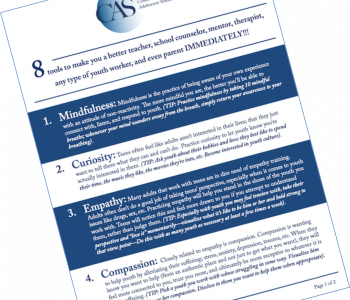

Sam Himelstein, PhD
Sam Himelstein is the founder and CEO of the Center for Adolescent Studies, Inc. He is passionate about working with youth and training the professionals that serve them.
Compassion Can Help You Work With Trauma-Impacted Youth
I remember the first time I felt true compassion for one of my clients. I was still in graduate school, working at the local juvenile detention camp. I remember the office at the camp. It wasn’t fancy. My partner and I (the other therapist who worked with me) were tucked away in what appeared to be an old service closet. There was even a cot in the room for detention staff who were working the graveyard shift. But the staff respected our space, and it was a place where I learned a lot of therapy and the vital role that compassion plays in trauma-informed care.
One evening I was working with a client I’ll call Eric (a pseudonym). He was literally one of two or three gang members from his gang in the camp. Everyone else was a rival gang member. At least at this camp, the young men from the gang that Eric was associated with were more likely to not have grown up in the United States with experiences of crossing the border. They had it rough, sometimes 2-3 or even just one of them in a sea of rival gang members. They were physically assaulted and could never let their guard down. They never felt safe. In an odd way, I believe that forced them to open up more in therapy because sometimes there was literally no one else they could confide in.
As our rapport grew, Eric told me more and more about his experiences growing up. He told me of the gruesome traumatic experiences of violence including being jumped by rival gang members, shot at, and countless other acts of violence. At the time in my career, no of this was news to me. But it was when he described his experience crossing the border with his mother that struck a cord with me. His facial expression changed. He wasn’t describing getting his ass kicked by a rival gang member or the “fucked up shit” he was going to do to them when he “caught them slippin.” It was like he reverted back to his 9 year old self. His innocence, his fear, his sense of not knowing what was going on, it all came back:
Eric: [With anguish on his face] Three days…
Me: Take your time … when you’re ready, I’m here…
Eric: [With tears are now running down his face] Three days we were out there. I was scared. I didn’t know what was going on. I was hungry. My mom looked scared. I’ll never forget that… [He shakes his head side to side in the “no” motion and starts to cry]
It was at this moment when I can confidently say that I truly felt compassion for one of my clients for the first time in the therapy room. I like to think of myself as a pretty compassionate person, and I had thought a lot about its role in therapy at that point in my young career. But that was the first time I could really feel it. Viscerally. I felt that strong desire for my client’s suffering to end, coupled with a deep caring, a deep sense of his human being-ness.
To be quite honest, I don’t even remember what I said next. I just remember being so present with him, with my own feeling, and having a deep knowing that what I was feeling was important in the therapy process. Later that week I found myself practicing a compassion meditation for Eric:
“May you be peaceful, may you be happy, may you heal from your trauma, may you be free from suffering” I found myself reciting silently.
I connected with the feeling that I felt in the room with him; it was vibrational, a visceral desire to want his suffering from that experience to end. I think it was in part due to the fact that while listening to his experience crossing the border, I could without hesitation or effort picture him as an innocent child; a cold, hungry, and scared 9-year old who didn’t know what was coming next. Walking for three days straight and hiding to “not get caught by the bad guys.”
After this experience, I found it easy to work with this client. Not because he was an easy client, he was actually deeply and multiply traumatized. He had many traumatic adaptations (i.e., behavioral outbursts) where he’d often act aggressively at the camp and at times be resistant in therapy. But for some reason after my experience of compassion the work just got easier for me. I took his aggressiveness and resistance in stride. Anytime he’d do something that would get him in trouble, or that would set him back in the camp’s discipline structure, or even if he’d get resistant or frustrated with me, it was just easy to picture him as a young child crossing the border. That didn’t mean I didn’t have healthy boundaries with him of course. When I needed to set one, I did. And because we had an authentic relationship, he often would respond well to my boundaries.
I learned on a visceral level from Eric that compassion can play a huge role in trauma-informed care. Over time our relationship became more authentic and trusting. He began to disclose more of his life experiences to me, offering me opportunities to connect with him, help him analyze his life situation, and even challenge him at times. He was released and shortly after we lost touch, but given where we started and where we ended, I’d consider our therapy successful.
Since then and over the years I’ve become much more intentional with building and practicing compassion with the youth I work with. I remember a few years after my experience with Eric I started experimenting with what it’d be like to explicitly send compassion to my clients before I met with them. I’d sit there for a few minutes before a client walked in or before a group started, would picture them, and send them compassion as I had learned to do through my meditation practice.
It was amazing. I’d be lighter, more easy-going in the group. Less worried about the schedule, less worried about having to perform in any way. This would loosen the group and ironically, deepen the dialogue around the content. And my relationships with the youth all deepened. I was hooked.
Being that I was into mindfulness and there were many mindfulness acronyms floating around, I ended up developing an acronym to help me practice compassion, especially with youth who had horrendous trauma experiences and who would “act out” (e.g., what many in the field would describe as a “traumatic adaptation”).
TAP
TAP stands for Take a breath, Acknowledge, and Proceed. I liked the euphemism of tapping into my experience first before actually saying or doing anything. The “take a breath” is a placeholder for pausing and becoming present. It’s the first step in skillfully responding to any tense situation, especially when working with trauma-impacted youth. Next, the “acknowledge” has two parts. First, acknowledge how you feel or what your experience is. For example, I might feel tense, frustrated, overwhelmed, etc. when a youth in a group starts disrespecting another youth. I want to acknowledge that and be present to it, because only then can I make sure it’s not dictating my experience, which could lead to an unskillful reaction to the situation.
The second part of the “acknowledge” is where I activate my compassion. After acknowledging my experience, I then acknowledge that this behavior, this resistance, could possibly be coming from a trauma response. That it could possibly be a way for this person to protect himself or herself. And when I do that, I can step out of my ego and explicitly send compassion. It can be hard, but it can also be trained (e.eg., you can get better at it with practice). The final step of TAP is the “proceed” part. That’s when you actually say or do something to intervene. This could be a skillful self-disclosure around the compassion you feel (if you feel it), a setting of a boundary, or even a non-verbal intervention. There are numerous interventions and that can be inserted into the “proceed” part of TAP, but that is for another post as I could write a book about the various interventions we can do in tense moments with youth.
I want to end this post with a brief description of how I practice compassion meditation, and particularly with difficult clients/students, as my hope is that you can take this practice, tailor it to your needs, and incorporate it into your work with young people. I am confident it will help you be more skillful, happy, and improve your relationship with the young people you work with.
Compassion Practice
Follow these simple instructions to practice harnessing compassion with the trauma-impacted youth you work with. I recommend doing this for your most difficult clients. Challenge yourself to do this over and over or as many times as you need.
Find a comfortable space where you can sit uninterrupted for about 5-7 minutes. Sit on a chair or on the floor in a way that won’t cause too much strain or pain for the duration of the exercise. If you need to lay back on a couch or lay down on the floor that’s okay.
Start by taking a few deep breaths in and deep breaths out.
Feel your breath in your body, feel all the sensations around the belly, the chest, the nostrils.
After a few more moments, bring forth an image of the youth you are working with that’s caused some stress.
Notice any feelings or thoughts that arise. If frustration arises, breathe with it. Don’t avoid it.
Then, visualize this teen as a child; an innocent child who hasn’t been hardened by the world’s experience yet. Imagining them as an infant is a good place to start. Every infant is innocent.
Next, contemplate the challenges this young person has had; the actual traumas you know about throughout his or her life.
Acknowledge that s/he, like all human beings are complex and nuanced, and that their disruptive, disrespectful, or difficult behaviors can be a way for them to protect themselves and can be a result of a trauma.
Finally, offer compassion by reciting silently while visualizing the youth:
May you be happy and peaceful
May you be healthy and safe
May you heal from the traumas you’ve endured
May your strengths shine through your armor
May you be free from suffering
I will then sometimes end this practice by thinking of some strength or resilience factor the young person has, as a way to connect with something they do right. That helps my mindset when I next encounter them.
I find myself thinking about or explicitly practicing this compassion exercise with most youth I work with at some point or another. When I practice, I really attempt to feel the quality of compassion at a vibrational level. At first it was just reciting what felt like empty phrases and statements. I was totally bought into meditation and the idea that compassion was useful, but harnessing it when it wasn’t there organically was hard. But, like anything else, after time and with training, I began to actually feel it, and that’s how that practice evolved for me.
Compassion is a critical aspect of fostering interpersonal safety and building a strong, trusting, alliance and relationship. It will also help you with other relationships in your life including the adults you deal with in the system you work in (which can sometimes be harder than the youth you work with), let alone your personal relationships.
Join the FREE Resilience Community for Helping Professionals to learn more about trauma-informed care, resilience, mindfulness, building relationships, and more! Our community features self-paced courses, a monthly live Zoom call, a weekly live meditation, and an online platform to connect with other providers/professionals in your field.
Related Posts
A Critical Intervention for Working with Traumatized Youth
10 Essential Guidelines for Teaching Meditation to Trauma-Impacted Youth
3 Ways Compassion Can Help Youth Impacted by Trauma
2 Simple Tips to Create a Welcoming, Trauma-Informed Classroom Space

